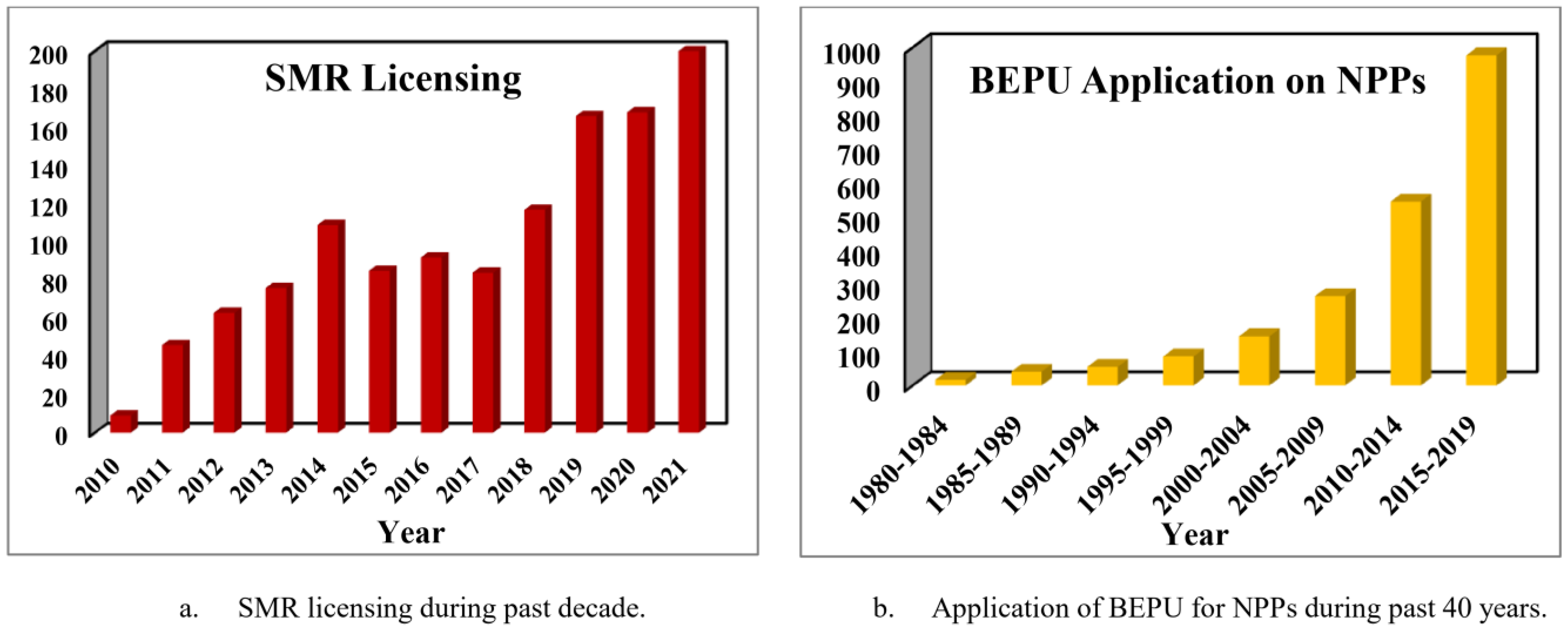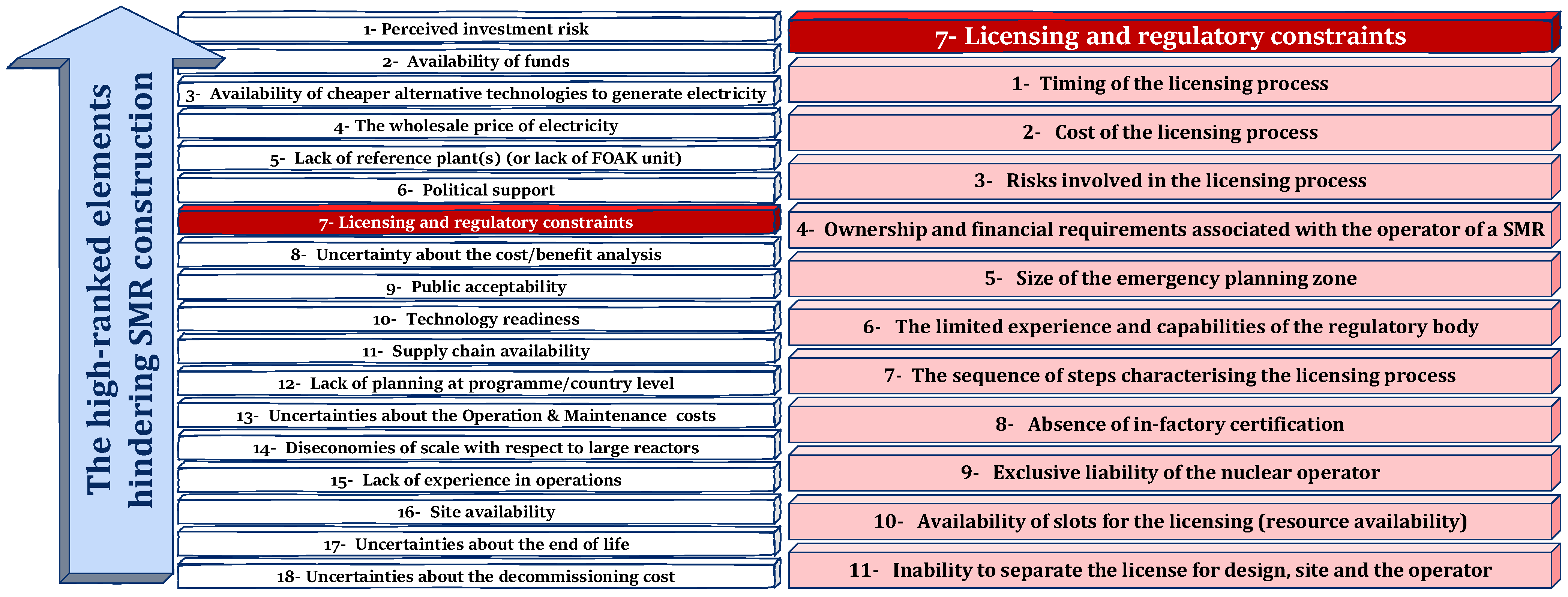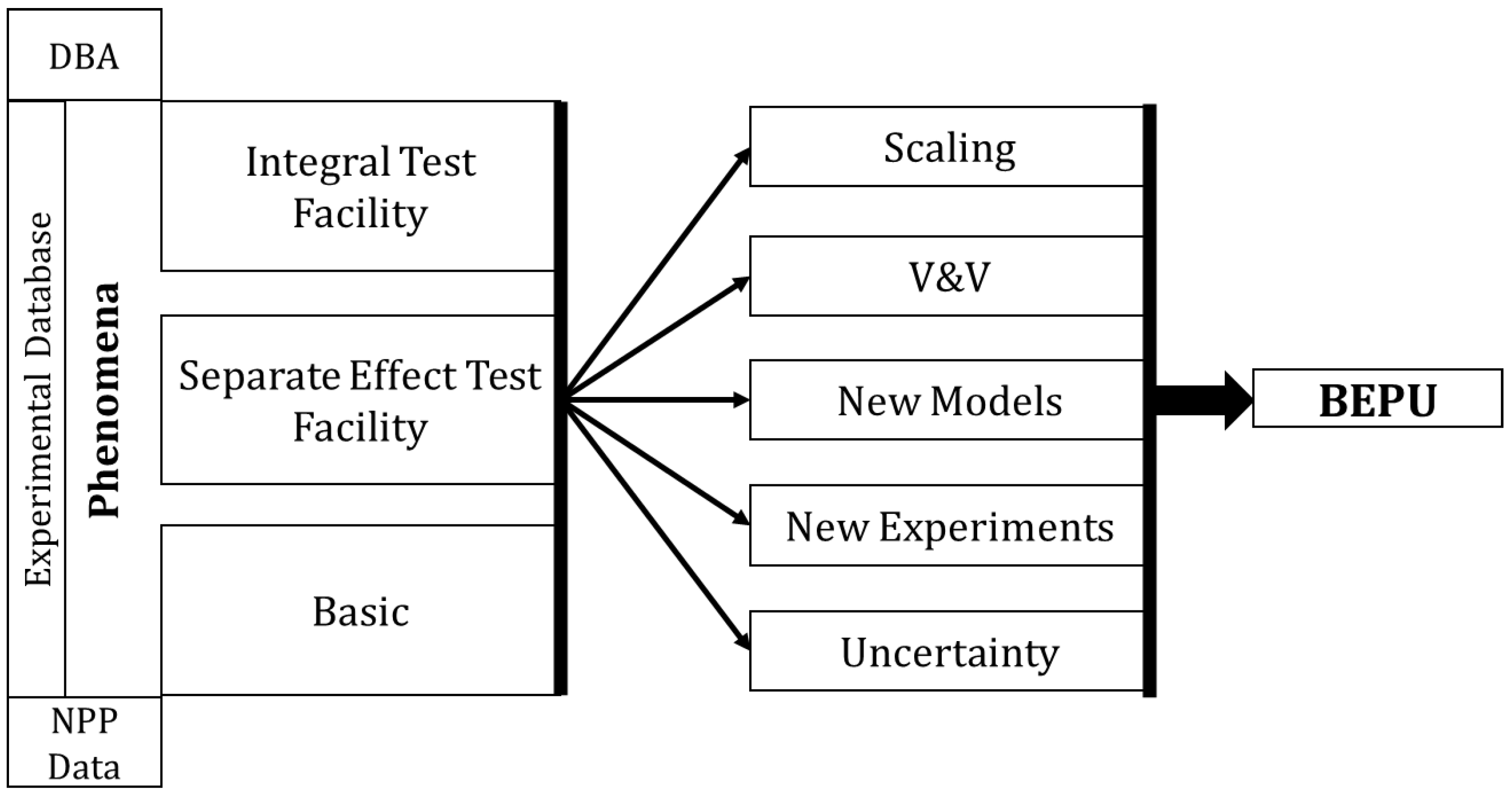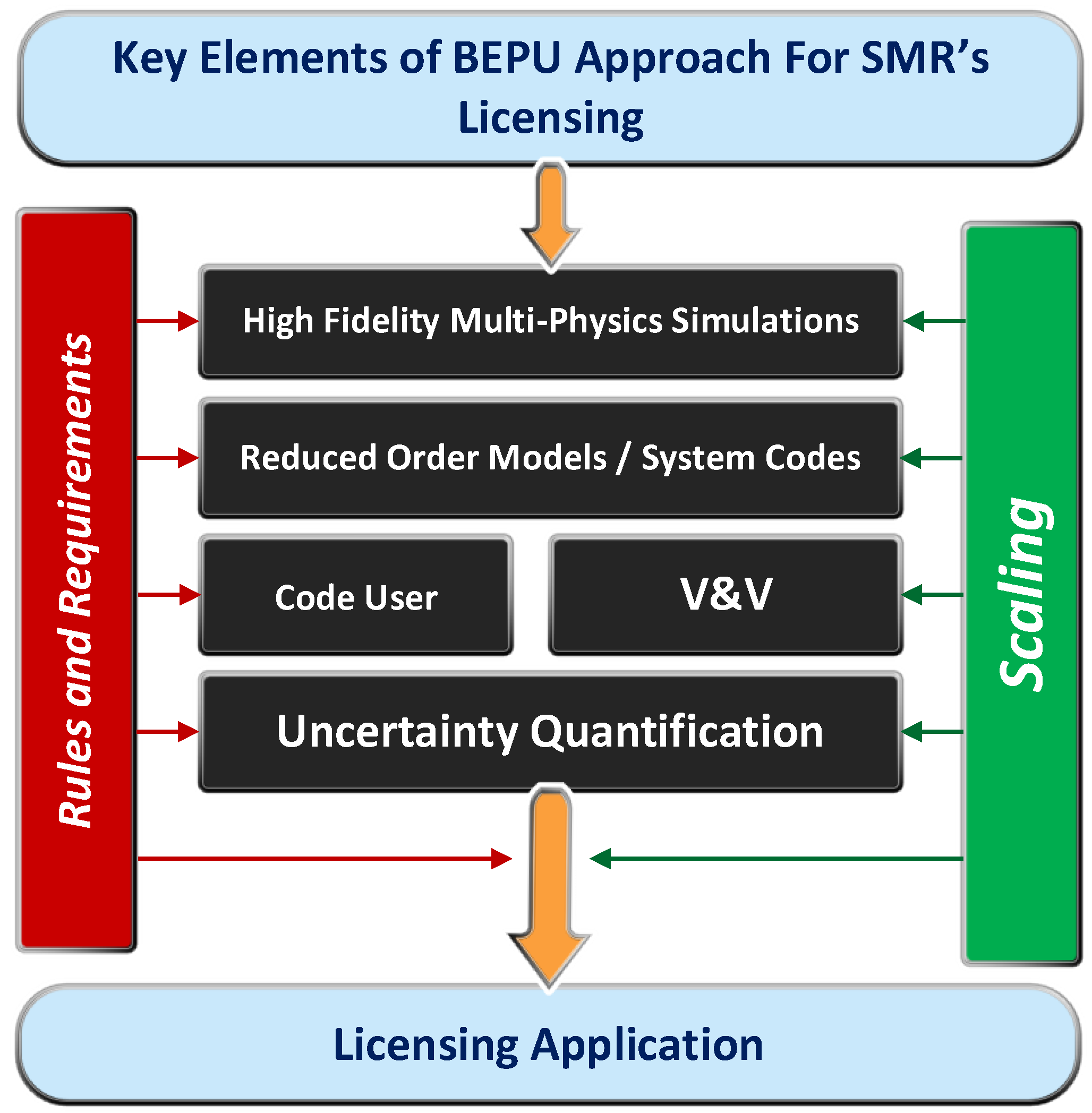Small Modular Reactors Licensing Process Based on BEPU Approach: Status and Perspective
Abstract
1. Introduction
2. Licensing Process Challenges for SMRs
3. BEPU Approach and Application Status
3.1. BEPU Concept
3.2. BEPU Application Experiences
4. Discussion and Final Remarks
Author Contributions
Funding
Institutional Review Board Statement
Informed Consent Statement
Data Availability Statement
Conflicts of Interest
References
- IAEA. Installations, Nuclear. In Safety Standards Series No. 110; International Atomic Energy Agency: Vienna, Austria, 1993. [Google Scholar]
- IAEA. Principles, Fundamental Safety. In IAEA Safety Standards Series No. SF-1; International Atomic Energy Agency: Vienna, Austria, 2006; Volume 2. [Google Scholar]
- INSAG-22; IAEA; International Nuclear Safety Group. Nuclear Safety Infrastructure for a National Nuclear Power Programme Supported by the IAEA Fundamental Safety Principles; International Nuclear Safety Group: Vienna, Austria, 2008. [Google Scholar]
- IAEA. Licensing the First Nuclear Power Plant, INSAG-26; International Atomic Energy Agency: Vienna, Austria, 2012. [Google Scholar]
- Bredimas, A.; Nuttall, W.J. An international comparison of regulatory organizations and licensing procedures for new nuclear power plants. Energy Policy 2008, 36, 1344–1354. [Google Scholar] [CrossRef]
- Söderholm, K.; Tuunanen, J.; Amaba, B.; Bergqvist, S.; Lusardi, P. Licensing process characteristics of Small Modular Reactors and spent nuclear fuel repository. Nucl. Eng. Des. 2014, 276, 1–8. [Google Scholar] [CrossRef]
- IAEA. Handbook on Nuclear Law: Implementing Legislation; International Atomic Energy Agency: Vienna, Austria, 2010. [Google Scholar]
- IAEA. Licensing Process for Nuclear Installations. In IAEA Safety Standards Series No. SSG-12; International Atomic Energy Agency: Vienna, Austria, 2010. [Google Scholar]
- NUREG-0800; Standard Review Plan for the Review of Safety Analysis Reports for Nuclear Power Plants. US Nuclear Regulatory Commission: North Bethesda, MD, USA, 1987.
- Wald, F. Small and Medium Power Reactors in developing countries—Present status. Nucl. Eng. Des. 1988, 109, 343–347. [Google Scholar] [CrossRef]
- Wrigley, P.A.; Wood, P.; O’Neill, S.; Hall, R.; Robertson, D. Off-site modular construction and design in nuclear power: A systematic literature review. Prog. Nucl. Energy 2021, 134, 103664. [Google Scholar] [CrossRef]
- Ricotti, M.E.; Fomin, R.V. Small Modular Reactors. Nuclear Reactor Technology Development and Utilization; Woodhead Publishing: Sawston, UK, 2020; pp. 187–211. [Google Scholar]
- Halimi, A.; Shirvan, K. Impact of core power density on economics of a small integral PWR. Nucl. Eng. Des. 2021, 385, 111488. [Google Scholar] [CrossRef]
- Akbari, R.; Ochbelagh, D.R.; Gharib, A.; Maiorino, J.R.; D’Auria, F. Small modular reactor full scope core optimization using Cuckoo Optimization Algorithm. Prog. Nucl. Energy 2020, 122, 103271. [Google Scholar] [CrossRef]
- Akbari-Jeyhouni, R.; Ochbelagh, D.R.; Maiorino, J.R.; D’Auria, F.; de Stefani, G.L. The utilization of thorium in small modular reactors–Part I: Neutronic assessment. Ann. Nucl. Energy 2018, 120, 422–430. [Google Scholar] [CrossRef]
- Michaelson, D.; Jiang, J. Review of integration of small modular reactors in renewable energy microgrids. Renew. Sustain. Energy Rev. 2021, 152, 111638. [Google Scholar] [CrossRef]
- Hosseini, S.A.; Akbari, R.; Shirani, A.S.; D’Auria, F. Analysis of the natural circulation flow map uncertainties in an integral small modular reactor. Nucl. Eng. Des. 2021, 378, 111156. [Google Scholar] [CrossRef]
- Akbari-Jeyhouni, R.; Ochbelagh, D.R.; Gharib, A. Assessment of an integral small modular reactor during rod ejection accident by using DRAGON/PARCS codes. Prog. Nucl. Energy 2018, 108, 136–143. [Google Scholar] [CrossRef]
- Carelli, M.; Garrone, P.; Locatelli, G.; Mancini, M.; Mycoff, C.; Trucco, P.; Ricotti, M. Economic features of integral, modular, small-to-medium size reactors. Prog. Nucl. Energy 2010, 52, 403–414. [Google Scholar] [CrossRef]
- Carelli, M.; Mycoff, C.W.; Garrone, P.; Locatelli, G.; Mancini, M.; Ricotti, M.E.; Trianni, A.; Trucco, P. Competitiveness of Small-Medium, New Generation Reactors: A Comparative Study on Capital and O&M Costs. In Proceedings of the 16th International Conference on Nuclear Engineering, Orlando, FL, USA, 11–15 May 2008. [Google Scholar]
- IAEA; Subki, H. Advances in Small Modular Reactor Technology Developments; International Atomic Energy Agency: Vienna, Austria, 2020. [Google Scholar]
- USNRC. 10 Code of Federal Regulations Part 20 §20.1003–Definitions. 2014. Available online: http://www.nrc.gov/reading-rm/doc-collections/cfr/part020/part020-1003.html (accessed on 20 February 2023).
- D’Auria, F.; Camargo, C.; Mazzantini, O. The Best Estimate Plus Uncertainty (BEPU) approach in licensing of current nuclear reactors. Nucl. Eng. Des. 2012, 248, 317–328. [Google Scholar] [CrossRef]
- Menzel, F.; Sabundjian, G.; D’Auria, F. BEPU-FSAR: A new paradigm in Nuclear Reactor Safety. In Proceedings of the ENS TOPSAFE 2017, Vienna, Austria, 12–16 February 2017; ENS (European Nuclear Society): Brussels, Belgium, 2017. [Google Scholar]
- Menzel, F.; Sabundjian, G.; D’Auria, F.; Madeira, A.A. Proposal for systematic application of BEPU in the licensing process of nuclear power plants. Int. J. Nucl. Energy Sci. Technol. 2016, 10, 323–337. [Google Scholar] [CrossRef]
- Prosek, A.; Mavko, B. Review of best estimate plus uncertainty methods of thermal-hydraulic safety analysis. In Proceedings of the International Conference Nuclear Energy for Central Europe 2003, Portorož, Slovenia, 8–11 September 2003. [Google Scholar]
- Trauger, D.B. Safety and licensing for small and medium power reactors. Nucl. Eng. Des. 1988, 109, 267–271. [Google Scholar] [CrossRef]
- Mignacca, B.; Locatelli, G.; Sainati, T. Deeds not words: Barriers and remedies for Small Modular nuclear Reactors. Energy 2020, 206, 118137. [Google Scholar] [CrossRef]
- Sainati, T.; Locatelli, G.; Brookes, N. Small Modular Reactors: Licensing constraints and the way forward. Energy 2015, 82, 1092–1095. [Google Scholar] [CrossRef]
- Sato, H.; Aoki, T.; Ohashi, H.; Yan, X.L. Research and development for safety and licensing of HTGR cogeneration system. Nucl. Eng. Des. 2020, 360, 110493. [Google Scholar] [CrossRef]
- IAEA. Safety of Nuclear Power Plants: Design. In IAEA Safety Standards Series No. SSR-2/1; International Atomic Energy Agency: Vienna, Austria, 2012. [Google Scholar]
- Betzler, B.R.; Heidet, F.; Feng, B.; Rabiti, C.; Sofu, T.; Brown, N.R. Modeling and simulation functional needs for molten salt reactor licensing. Nucl. Eng. Des. 2019, 355, 110308. [Google Scholar] [CrossRef]
- Ramana, M.V.; Hopkins, L.B.; Glaser, A. Licensing small modular reactors. Energy 2013, 61, 555–564. [Google Scholar] [CrossRef]
- IAEA. Format and Content of the Safety Analysis Report for Nuclear Power Plants; International Atomic Energy Agency: Vienna, Austria, 2004. [Google Scholar]
- D’Auria, F. Best Estimate Plus Uncertainty (BEPU): Status and perspectives. Nucl. Eng. Des. 2019, 352, 110190. [Google Scholar] [CrossRef]
- IAEA. Best Estimate Safety Analysis for Nuclear Power Plants: Uncertainty Evaluation. In Safety Reports Series No. 52; International Atomic Energy Agency: Vienna, Austria, 2008. [Google Scholar]
- IAEA. Deterministic Safety Analysis for Nuclear Power Plants. In IAEA Safety Standards Series No. SSG-2 (Rev.1); International Atomic Energy Agency: Vienna, Austria, 2019. [Google Scholar]
- D’Auria, F. Best-Estimate Plus Uncertainty (BEPU) approach for accident analysis. In Thermal-Hydraulics of Water Cooled Nuclear Reactors; Woodhead Publishing: Sawston, UK, 2017; pp. 905–950. [Google Scholar]
- Bocanegra, M.R. Towards a Bepu Methodology for Containment Safety Analyses. Ph.D. Thesis, Technical University of Madrid, Madrid, Spain, 2019. [Google Scholar]
- D’Auria, F.; Galassi, G.M.; Mazzantini, O. The best estimate plus uncertainty approach in licensing of Atucha II. In Pressurized Heavy Water Reactors; Elsevier: Amsterdam, The Netherlands, 2022; pp. 51–204. [Google Scholar]
- Miao, H.; Lind, M.; Zhang, X.; Wu, J. Quantifying performance of passive systems in an integrated small modular reactor under uncertainties using multilevel flow modelling and stochastic collocation method. Prog. Nucl. Energy 2022, 149, 104279. [Google Scholar]
- Kumar, D.; Alam, S.B.; Ridwan, T.; Goodwin, C.S. Quantitative risk assessment of a high power density small modular reactor (SMR) core using uncertainty and sensitivity analyses. Energy 2021, 227, 120400. [Google Scholar] [CrossRef]
- Alcaro, F.; Bersano, A.; Bertani, C.; Mascari, F. BEPU analysis of a passive decay heat removal system with RELAP5/MOD3. 3 and RELAP5-3D. Prog. Nucl. Energy 2021, 136, 103724. [Google Scholar] [CrossRef]
- Zhang, H.; Mousseau, V.; Zhao, H. Development of a High Fidelity System Analysis Code for Generation IV Reactors; No. INL/CON-07-13363; Idaho National Lab. (INL): Idaho Falls, ID, USA, 2008. [Google Scholar]
- D’auria, F.; Lanfredini, M.; Muellner, N. Scaling analysis in BEPU licensing of LWR. Nucl. Eng. Technol. 2012, 44, 611–622. [Google Scholar] [CrossRef]
- Bucalossi, A.; Petruzzi, A.; Kristof, M.; D’Auria, F. Comparison between Best-Estimate–Plus–Uncertainty Methods and Conservative Tools for Nuclear Power Plant Licensing. Nucl. Technol. 2010, 172, 29–47. [Google Scholar] [CrossRef]
- Sartori, A.; Cammi, A.; Luzzi, L.; Rozza, G. A multi-physics reduced order model for the analysis of Lead Fast Reactor single channel. Ann. Nucl. Energy 2016, 87, 198–208. [Google Scholar] [CrossRef]
- Alsayyari, F.; Tiberga, M.; Perkó, Z.; Lathouwers, D.; Kloosterman, J.L. A nonintrusive adaptive reduced order modeling approach for a molten salt reactor system. Ann. Nucl. Energy 2020, 141, 107321. [Google Scholar] [CrossRef]
- Santanoceto, M.; Tiberga, M.; Perkó, Z.; Dulla, S.; Lathouwers, D. Preliminary uncertainty and sensitivity analysis of the Molten Salt Fast Reactor steady-state using a Polynomial Chaos Expansion method. Ann. Nucl. Energy 2021, 159, 108311. [Google Scholar] [CrossRef]
- Vergari, L.; Cammi, A.; Lorenzi, S. Reduced order modeling for coupled thermal-hydraulics and reactor physics problems. Prog. Nucl. Energy 2021, 140, 103899. [Google Scholar] [CrossRef]
- German, P.; Tano, M.; Fiorina, C.; Ragusa, J.C. GeN-ROM—An OpenFOAM®-based multiphysics reduced-order modeling framework for the analysis of Molten Salt Reactors. Prog. Nucl. Energy 2022, 146, 104148. [Google Scholar] [CrossRef]
- Huang, D.; Abdel-Khalik, H.; Rabiti, C.; Gleicher, F. Dimensionality reducibility for multi-physics reduced order modeling. Ann. Nucl. Energy 2017, 110, 526–540. [Google Scholar] [CrossRef]








 |  |  |  |  | ||
|---|---|---|---|---|---|---|
| Pre-Licensing | Statement of Licensing Feasibility | State of Safety by ASN * | Generic Design Assessment | Vendor Design Review | Environmental Impact Assessment | |
| Political | Policy Decision | Investment Plan | - | - | Principle Decision | |
| Licensing on New Nuclear Facilities | Standard Design ApprovalDesign Certification | Authorization for Nuclear Reactor Creation | Site License | Environmental Assessment | License to Construct | |
| Combined Operating License | Construction Permit | - | Established Hold Points by Regulatory | Construction License | License to Operate | |
| ITAAC ** | Operating License | - | - | Operating License | - | |
| Country | Permission to Use BE Codes |
|---|---|
| Belgium | 🗸 |
| Canada | 🗸 |
| Czechia | 🗸 |
| Finland | 🗸 |
| France | 🗶 Not, for DBA 🗸 Yes, for BDBA |
| Japan | 🗸 |
| Spain | 🗸 |
| United Kingdom | 🗸 |
| United States | 🗸 |
| United States of America |
|
| Russia |
|
| South Korea |
|
| China |
|
| India |
|
| Option | Computer Code | The Assumption about the Availability of the System | Type of the Initial and Boundary Conditions |
|---|---|---|---|
| 1- Conservative | Conservative | Conservative assumption | Conservative input data |
| 2- Combined | Best-Estimate | Conservative assumption | Conservative input data |
| 3- BEPU | Best-Estimate | Conservative assumption | Realistic input data with uncertainties: partly most unfavorable condition |
| 4- Risk-Informed | Best-Estimate | Derived From PSA | Realistic input data with uncertainties |
| Sample Application | Brief Description | Outcomes & Messages |
|---|---|---|
| Angra-2 PWR | The BEPU application is applied for LB-LOCA scenario assessment in Angra-2 NPP. |
|
| Kozloduy-3 VVER-440 | Two BEPU applications are applied for LOCA and LB-LOCA in Kozloduy-3 NPP. |
|
| Smolensk-3 RBMK | Several accident scenarios are concerned with BEPU in Smolensk-3 channel type NPP. |
|
| Atucha-II PHWR | the BEPU approach applied to the “Transient and Accident Analysis” chapter of FSAR |
|
| Balakovo-3 VVER-1000 | Various long-lasting accident scenarios using BEPU |
|
| Peach Bottom-2 BWR | The turbine trip scenario is concerned with BEPU |
|
Disclaimer/Publisher’s Note: The statements, opinions and data contained in all publications are solely those of the individual author(s) and contributor(s) and not of MDPI and/or the editor(s). MDPI and/or the editor(s) disclaim responsibility for any injury to people or property resulting from any ideas, methods, instructions or products referred to in the content. |
© 2023 by the authors. Licensee MDPI, Basel, Switzerland. This article is an open access article distributed under the terms and conditions of the Creative Commons Attribution (CC BY) license (https://creativecommons.org/licenses/by/4.0/).
Share and Cite
Hosseini, S.A.; Akbari, R.; Shirani, A.S.; D’Auria, F. Small Modular Reactors Licensing Process Based on BEPU Approach: Status and Perspective. Sustainability 2023, 15, 6636. https://doi.org/10.3390/su15086636
Hosseini SA, Akbari R, Shirani AS, D’Auria F. Small Modular Reactors Licensing Process Based on BEPU Approach: Status and Perspective. Sustainability. 2023; 15(8):6636. https://doi.org/10.3390/su15086636
Chicago/Turabian StyleHosseini, Seyed Ali, Reza Akbari, Amir Saeed Shirani, and Francesco D’Auria. 2023. "Small Modular Reactors Licensing Process Based on BEPU Approach: Status and Perspective" Sustainability 15, no. 8: 6636. https://doi.org/10.3390/su15086636
APA StyleHosseini, S. A., Akbari, R., Shirani, A. S., & D’Auria, F. (2023). Small Modular Reactors Licensing Process Based on BEPU Approach: Status and Perspective. Sustainability, 15(8), 6636. https://doi.org/10.3390/su15086636






